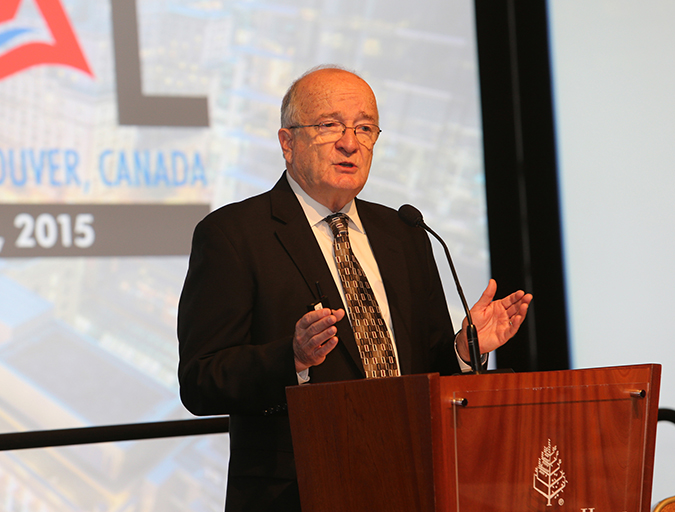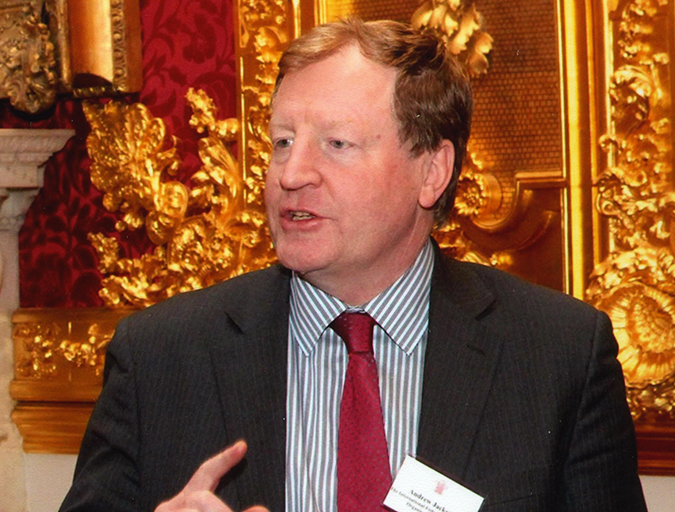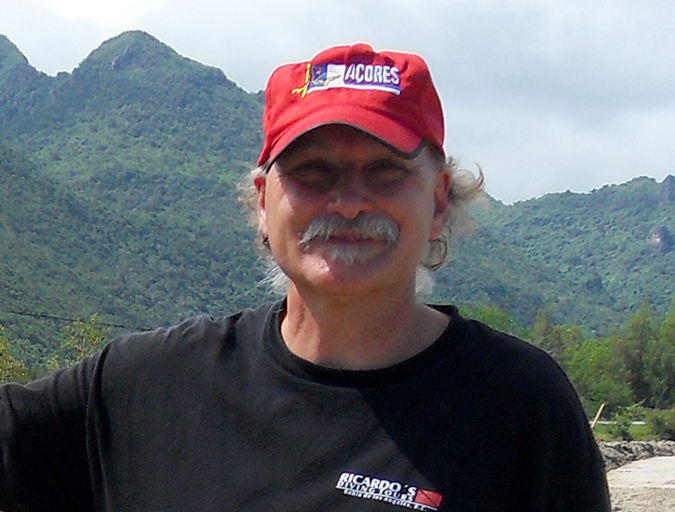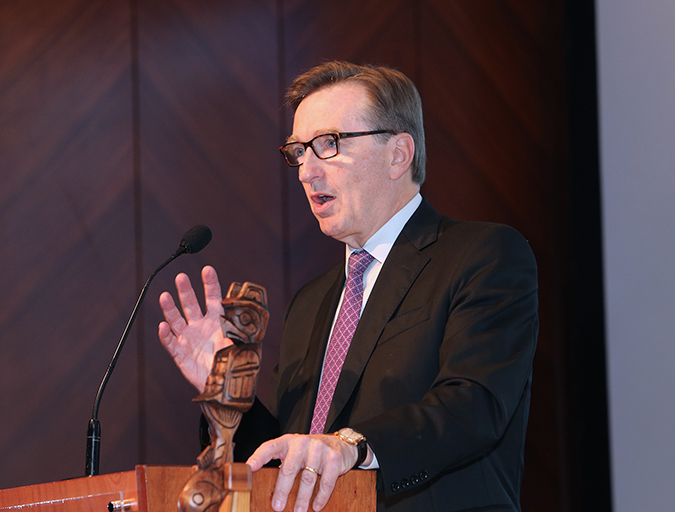Longtime GAA supporter discusses Lifetime Achievement Award and lobster aquaculture

Bill Herzig, former seafood procurement executive for Darden Restaurants, has long recognized the potential for aquaculture in steadying supplies of shrimp and other products his company depended on. Darden, at the time the parent company of Red Lobster, the largest seafood restaurant chain in the United States, was one of the biggest supporters of the Global Aquaculture Alliance during its formative years. For all of his efforts and dedication, GAA will honor Herzig with a Lifetime Achievement Award later this month at its annual GOAL conference in Vancouver.
Herzig is now President of Sustainable Strategies and Initiatives, a consulting business he started earlier this year after his 18-year career with Darden came to a close. He calls it his “retirement business to keep me out of thinking that I could help my wife organize the household.” But to hear him speak, his work in aquaculture isn’t finished. He says the ambitious lobster aquaculture project in Malaysia that he managed for Darden still has life.
Congratulations on your Lifetime Achievement Award from the GAA. Can you share your feelings about this recognition and talk about your history in aquaculture?
I feel of course honored and humbled, but I also feel a deep sense of satisfaction and pride that a group of people put their time and energy and money and resources toward doing something that would benefit the industry as a whole. They looked beyond their own individual needs.
I guess I’d probably start back with what George Chamberlain and I were thinking about in the very beginning. The industry was a young industry. An article titled the “Blue Revolution” talked a lot about the promise of aquaculture and what it had the potential to do in terms of creating sustainable food for the people not only in developed economies but in places around the world where food production wasn’t at the level that was going to support the population long-term.
When George was working for Ralston Purina in the late 80s or early 90s, and I was running a manufacturing and procurement operation at SeaPak, we crossed paths working on shrimp that was being aquacultured in Mexico. We began to put on seminars to train customers. For us, it was the Blue Revolution really starting to happen. I guess, fast forward to where we are today, I think what GAA has done, with the help of sweat equity from George and Wally [Stevens] and a host of people who devoted their lives to it, I think we’ve laid a foundation —with the standards, the magazine, the GOAL meeting to bring people together to talk about the salient issues — that has really allowed for aquaculture’s best days to be in its future.
Did you know early on that aquaculture would grow to this scale in just 20 years?
I’ve always that thought aquaculture would be a huge part of the solution to fed the world long-term. A couple years ago, the FAO came out and said that we need to produce 60 percent more food by mid-century, or by 2050, than we do today. If you look at raising cattle — there’s not going to be any more Montanas created. It’s a little hard to find places to raise more cattle. And not so easy to find places to raise pigs. And when you talk about feed conversions, cattle are like 7:1, pigs are 3:1 — chickens and seafood are the most efficient feed converters, somewhere between 1 and 1 and a half pounds of feed for pounds of output. It’s extremely efficient.
Where we’ve come today, with biofloc and every bit of waste that goes into a farm is being aerobically digested, being part of the vertical food chain, you can produce 30,000 to 40,000 pounds of shrimp in one hectare of space, and to potentially do that three times a year? That is just an enormously efficient system.
Improvement work in aquaculture really began in the late 1990s, right?
The problem was that the problems that arose in one location — like cutting mangroves, or not building farms in a way that was sustainable, using feeds that either weren’t efficient or weren’t sustainable — everyone was having a go at it in their own individual country. There was no way to take lessons learned in one country and share them in another. The goal of GAA was to share what had happened in terms of mistakes that had made so that everybody could learn from them and that the industry could become a force for good, not just for a series of rolling mistakes in new locations.
It’s what I enjoy most about the work I do with GAA, the sense that we’re all in it together. With some people, you can see the passion and the commitment they make to take this as sort of a sacred trust on their own and take it to the next level.
What do you see as noteworthy examples of pre-competitive work today?
I would cite Jeff Sedacca and the work he’s doing to support cluster farms with National Fish & Seafood. Kim Lopdrup, president of Red Lobster, became passionately committed to seeing this work and to support GAA in any way he could to bring about a more sustainable frame of working together. I see it when I go to board meetings, at GOAL; I see people who truly have that spark. With some people, you can see the passion and the commitment they make to take this as sort of a sacred trust on their own and take it to the next level. Lee Bloom (Eastern Fish Co.) has been hugely influential in his own quiet way behind the scenes, being a supporter and bringing customers in. They get the we, in addition to the me. It’s what I enjoy most about the work I do with GAA, the sense that we’re all in it together.
Not long ago, individual jobs dedicated to sustainability didn’t exist. That seems to be one of the biggest differences in today’s business.
At Darden I worked with some great people who had sustainability as their primary role. But we made sustainability part of how we thought about the business. You didn’t hire the guy who focused just on sustainability, and the rest of it was business as usual. What we tried to do was get our team to understand that sustainability was how we had to operate the business. The person we brought in to be the sustainability person, their role was to integrate the best-practices thinking about sustainability into our everyday business decisions. It’s just good business; it’s a good way to live your life.
Talk to me about the lobster aquaculture operations Darden began in Malaysia and where it stands today.
One day I was giving Kim a seafood supply update, with a particularly depressing update on the status of lobster. It’s all from wild harvest as it sits today, subject to intense surges in demand, contractions in supply, and prices go all over the place — makes it hard to plan menus for a restaurant company. I had taken him to a couple of GAA meetings, and told him about how aquaculture had changed the industry and how companies operated with more stability. You still have bouts with disease, and market shifts and, like all commodities, it can be somewhat volatile.

So Kim, in his infinite understated way, asked me what I thought about lobster aquaculture. I knew him really well by then, and I thought, “Oh God. I’m about to get a project.” I was so busy buying about $2 billion of everything from seafood to pork, beef, chicken, small-wares, oils, grains, cheeses. I had a very full plate, and a great team working with me, but I was going about as flat-out as I could. But Kim, being the smart and persistent guy that he is, said, “I want you to take some Red Lobster money and go see what it would take to make lobster aquaculture happen.”
So, I went back to my office, thought about slashing my wrists, ruled that out pretty quickly, then called Mike Powers, my top guy in lobster into my office, and I said, “Mike, we’ve got a project. We’ve got to sit down and figure out the pathway to maybe make lobster aquaculture happen.”
We knew we were businessmen and not scientists. We found a gentlemen named Dr. Andrew Jeffs from New Zealand, one of the foremost lobster scientists in the world. We began to develop a research plan and laid out a whole series of long-term problems that would need to be solved, and the research that needed to be done. That took about a year. And out of the summary of that what we learned, what I was hoping for, in all candor, was that it would be scientifically so difficult that it made no sense to pursue it! So then I could wash my hands and get back to my day job!
It turned out that a lot of people who had done the research had made some fundamental mistakes, which I won’t get into. Basically if those were not repeated, it might give you a pathway to successfully developing aquaculture. The Reader’s Digest version is that as we progressed on that research it was indeed highly possible. It was not simple. It would take a lot of capital to complete the research and then a significant amount to develop a fully developed system, with a hatchery, grow-out and a feed mill. We began to do the research along that path and today, we know how to breed lobster, produce offspring and do it cost effectively. There’s more research that needs to be done in all three buckets, but basically we’ve got all three legs of the stool developed to commercialize it.
What’s the status of the operation now?
It’s still a work in progress. Darden, when its board transitioned last year, decided to back out of funding the project, which is what led me to retire. Now we are working on recapitalizing the project, which is still in Malaysia, it’s still operating, but we’ve got to recapitalize to take it to its ultimate successful outcome. I’d be remiss not to also call out Shah Faiez, who helped us work with the Malaysian government to get access to sea sites and get incentives to put that together.
Now that you've reached the end of the article ...
… please consider supporting GSA’s mission to advance responsible seafood practices through education, advocacy and third-party assurances. The Advocate aims to document the evolution of responsible seafood practices and share the expansive knowledge of our vast network of contributors.
By becoming a Global Seafood Alliance member, you’re ensuring that all of the pre-competitive work we do through member benefits, resources and events can continue. Individual membership costs just $50 a year.
Not a GSA member? Join us.
Author
-
James Wright
Editorial Manager
Global Aquaculture Alliance
Portsmouth, NH, USA
Related Posts

Innovation & Investment
Service, passion will grow aquaculture responsibly
GAA Executive Director Wally Stevens reflects on Veteran's Day and Remembrance Day and urges all aquaculture leaders to serve the industry in a pre-competitive manner. Service is defined, he said, by an individual’s ability to put aside the needs of his or her organization and confront shared challenges.

Aquafeeds
Aquaculture Exchange: Andrew Jackson, IFFO
Aquaculture remains dependent on fishmeal and fish oil, crucial marine ingredients in aquafeeds, particularly at key life stages. Andrew Jackson, technical director at IFFO and one of the world’s foremost fishmeal experts, tells the Advocate that the two industries can coexist well into the future if properly managed.

Innovation & Investment
Aquaculture Exchange: Barry Costa-Pierce, UNE
University of New England Professor Barry Costa-Pierce says aquaculture is often neglected in studies examining ocean health and ecosystem and resource management. The “Ocean Prosperity Roadmap” released this summer, he said, was more of the same.

Innovation & Investment
GOAL Day 3: The greater good
A jam-packed three days of important dialogue in Vancouver was capped off by a keynote from the CEO of one of Canada’s oldest seafood companies, a suite of aquafeed innovations and a moving acceptance speech from Bill Herzig, the GAA Lifetime Achievement Award recipient.



